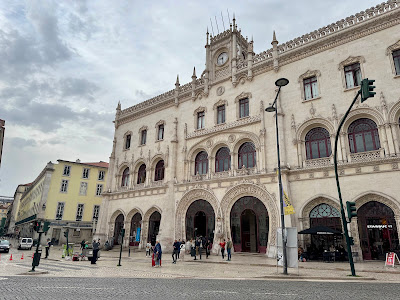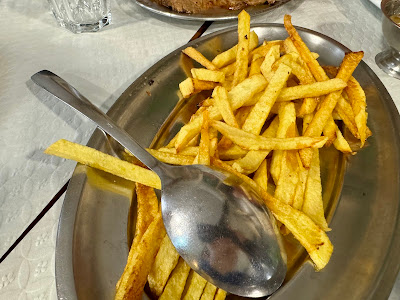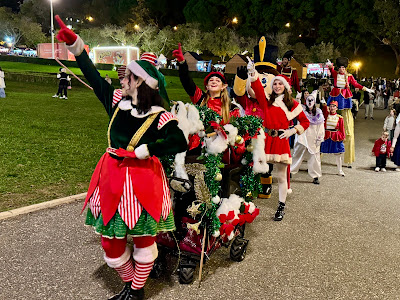Lisbon, Portugal Day 1
Our last trip in 2024 was to Lisbon, the capital of Portugal. We arrived in Lisbon in the early morning. After dropping our luggage at our hotel, we had a breakfast at a bakery called Fábrica da Nata, a Portuguese pastry shop that specializes in Pastéis de Nata, traditional Portuguese egg tarts!
Our egg tarts were still warm. The crust was thin and tender. The custard cream filling was very soft and light with a caramelized surface. So tasty! My own primary mission of this trip was tasting of Pastéis de Nata. This first egg tart became my standard. In fact it looked that every single bakery, pastry shop, cafe and grocery store in Lisbon offers egg tarts. It was easy to find one but you would need some research, experience and/or luck to discover your favorite one.
We started walking around the city of Lisbon. The late 18th century, Neo-Manueline style building was the Rossio railway station.
Castelo de São Jorge was seen on the hill.
Built in 1902, the cast-iron elevator, Santa Justa Lift is one of the city's popular tourist attractions.
We strolled on R. Augusta, a famous pedestrian street that has the Arco do Triunfo or Arch of Triumph at the end. The large Baroque Revival style arch was built between 1755 and 1873 to commemorate the reconstruction of Lisbon following the 1755 earthquake.
The arch overlooked Praça do Comércio, one of the largest squares in Europe, built on the site of the former Royal Palace that was destroyed by the 1755 earthquake. The square is pretty much empty today but at least a tall Christmas tree filled the space a bit when we were there.
The square faces the Tagus River to the south. There was a historic pier called the Cais das Columnas, where the Royal boats of the noble guests would dock.
The old trams were running around the city, which created a very Lisbon-like scenery.
We climbed up a slope. Just like Rome, Lisbon was built on seven hills. A lot of up and down slopes and staircases during city walk were expected naturally.
Eventually we arrived at Miradouro de Santa Catarina, one of the city's viewpoints. The statue of Adamastor, a mythical sea monster was there.
We happened to get the top end of Elevador da Bica, one of three Lisbon's iconic funiculars. The cute yellow funicular was covered with many tourists who were taking photos with it.
I hadn't known that Portugal is famous for high-end soap manufacturing until this trip. I just found a store of Benamôr, a natural beauty brand born in 1925. We stepped in and bought a couple of their lovely scented soaps.
We arrived at Praça Luís de Camões, a city square with the statue of the renowned 16th century Portuguese poet Luís de Camões at the centre. We passed by the square many times during the trip. No matter where we headed, we almost always hit the square somehow.
Our lunch place was Zé da Mouraria, a traditional Portuguese restaurant in Mouraria, or Moorish quarter. Our friend who currently lives in Lisbon joined us. It was great to meet up with her there!
The restaurant was hidden on a quiet, narrow, perhaps residential street. We were seated in the second dining room next to the main dining room. Both were fully packed by the time we left there.
Our friend kindly helped us order traditional foods as well as the restaurant's specialties. Starters were bread, cheese and olives.
Garlic steaks were very tender and flavorful, accompanied with fries.
Bacalhau, or Portuguese dried and salted cod was amazingly delicious. Bacalhau is the most popular base ingredient in Portuguese cooking and I was happy to have a chance to taste it on the arrival day already. The fish was served with onions, garlics, roasted potatoes and chickpeas. I have never seen a dish that was accompanied with that large amount of chickpeas. The seasoning was simple, perhaps just with olive oil, and the dish wasn't salty at all.
Coriander rice was also wonderful. Everything was delicious. By the way the portion of the dishes was generous as our friend told us in advance when she recommended this place along with others. In fact, we got the half size of both the steak and the cod dishes. According to her, traditional Portuguese restaurants tend to serve a large portion. It was good to know!
Our friend guided us in the city after the big and excellent lunch. We briefly saw the inside of Church of Saint Dominic. Originally built in the mid-13th century, the church still manages to stand after significant damages by two earthquakes (1531 and 1755) and a massive fire (1959). It looked like a 'living-ruin' if there is such a thing.
Roasted chestnut vendors were seen here and there in the city. Although we love roasted chestnuts, their heavy smoky smell didn't appeal us.
We walked up on Avenia da Liberdade, the city's most famous and luxurious promenade. It was Sunday and a holiday, Portugal Restoration of Independence Day. The main road was blocked and many marching bands were gathering there, performing or preparing for their turns.
We passed by the Praça Marquês de Pombol, a huge roundabout with a statue of the Marquess of Pombal, who was the prime minister of King Joseph I from 1750 until 1777 and rebuilt the city after the 1755 earthquake, and walked through the Parque Eduardo VII, a huge public park spreading behind the roundabout.
A Christmas market was held in the park. There were many food and souvenir vendors. Even though many things they offered weren't necessarily Christmas-y, people in Lisbon must enjoy the festive atmosphere. J tried a small shot of Ginjinha (simply Ginja), a Portuguese sour cherry liqueur, which was served in a little chocolate cup. He liked the liqueur as much as he added the liqueur in his shopping list.
Once we reached a viewpoint in the park, we could see the public park was quite large and built on a wide slope.
We walked further and visited two museums: Centro de Arte Moderna Gulbenkian (CAM) and Calouste Gulbenkian Museum. There were some interesting Japanese arts in the CAM while the wide range of the collections of the Gulbenkian Museum, particularly oriental rugs and ceramics as well as the marvelous Art Nouveau jewelry by René Lalique were impressive.
We walked a lot and deserved something sweet. Our friend took us to Landeau Chocolate, a cafe situated on the food court floor of El Corte Inglés, Spain's department store chain. Actually the cafe was on my must-go list. They offer various drinks but only one thing to eat - their master chocolate cake.
After a couple of bites, I understood why people say it's the best chocolate cake. The cake was almost like a creamy chocolate mousse. Super rich but somewhat light. Not so sweet but heavenly chocolate-y, which I loved. First I thought J and I could get one slice to share but we both got a slice each. It was wise to do so.
When we left the department store, it was already dark outside. The Christmas market was lit up cheerfully and got so crowded. We happened to run into a march of elves(?).
The lights on the main street also lit up neatly. The warm winter in Lisbon didn't really suit Christmas decorations but allowed us to be active in the city without a winter jacket.
To be continued...
















































